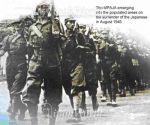We've tried to ensure the information displayed here is as accurate as possible. Should there be any inaccuracies, we would be grateful if you could let us know at info@ipohworld.org . All images and content are copyright.
(Please click on the thumbnail for a bigger image.)
Malayan Peoples’ Anti Japanese Army (MPAJA) Marching Through The Street

Taken from the album of Dato Seri, a picture of the MPAJA marching through a street in Perak on 2 December 1945 after the surrender of the Japanese in August that year.
The Emergency has its roots in the Japanese invasion of British Malaya, when the Colonial authorities, desperate, began to train members of the Communist Party of Malaya (CPM) in jungle warfare and subsequently guerrilla warfare to defend against the Japanese onslaught. The graduating cadres moved into the jungles and formed the Malayan People’s Anti-Japanese Army (MPAJA). Once the Japanese had surrendered and the British returned to Malaya, the MPAJA were called to surrender their arms. However, their true strength was kept secret and several caches of arms were secretly hidden in the jungle for the day when the Communists would take up their armed struggle against the British. Although the MPAJA was disbanded, the Communist networks were maintained through the Ex-Services Comrades' Association, founded on 1 December 1946, with branches all over Malaya.
On June 16, 1948, a 'State of Emergency' was declared by the government, after three British planters (Arthur Walker, John Allison and Ian Christian) from the Elphil and Sungai Siput estates were killed in cold blood by two different Communist guerilla groups. The murders were the culmination of the last few years of industrial conflict, rural upheaval and social revolt in Malaya.
Over the next few days, police stations were targeted, buses burnt, trains derailed, trucks hijacked, and rubber plantations and tin mines were attacked. The Colonial government construed these events as an open declaration of war by the Communists against the British and reciprocated with large-scale arrests of Communists and the banning of several organisations including the Communist Party of Malaya, the Ex-Services Comrades' Association and the New Democratic Youth League.
After the assassination of the British Resident, Henry Gurney, on October 5 1951, long-term counter-insurgency measures were further stepped up, including the implementation of the Briggs Plan, where 500 000 mainly Chinese squatters on the fringe areas were relocated to cut off food and supplies to the communists. These long term measures were effective but there followed 12 years of terrorism which took many lives both service and civilian. Finally, on July 31, 1960, the government proclaimed the Emergency over.